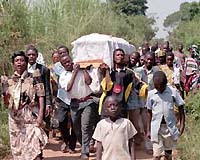 |
San Diego CA (SPX) Oct 08, 2010 Influenza pandemics often come in multiple waves. As the one wave subsides, public health officials have to decide whether continuing vaccination programs is warranted to prevent or reduce a subsequent wave. In a new study published in the November issue of the American Journal of Preventive Medicine, researchers report on a new computer model that can be used to predict both subsequent-wave mechanisms and vaccination effectiveness. They conclude that additional waves in an epidemic can be mitigated by vaccination even when an epidemic appears to be waning. As part of ongoing work with the Office of the Assistant Secretary for Preparedness and Response at the U.S. Department of Health and Human Services during the H1N1 influenza pandemic, the University of Pittsburgh Models of Infectious Disease Agent Study (MIDAS) team employed an agent-based computer simulation model of the Washington, DC metropolitan region to delineate what mechanisms could generate a subsequent (e.g., "third) epidemic wave" and explored whether vaccinating the population at different rates and times would mitigate the wave. This model included explicit representations of the region's individuals, school systems, workplaces/commutes, households, and communities. "The present study identified potential mechanisms for a multiple-wave influenza epidemic and demonstrated how vaccination can mitigate additional waves, thereby supporting the continuation of a vaccination program even when an epidemic appears to be waning, as in December 2009 -January 2010," commented lead investigator Bruce Y. Lee, MD, MBA, University of Pittsburgh School of Medicine and Graduate School of Public Health. "Although vaccinating a population before an epidemic begins is ideal, public health decision makers should not rule out initiating a vaccination program even though they know that the vaccine will not arrive in time to affect the initial wave of an epidemic. "Uncertainties remained for decision making by public health officials on the question of dedicating resources and credibility to the H1N1 vaccination program. However, these simulations do lend support for continuation of the program and to continued public education on the benefits of receiving the vaccine." Four mechanisms have been identified that could cause a subsequent (e.g., third) epidemic wave: substantially increased viral transmissibility that changes with the seasons; progressive viral adaptation; an immune escape variant; and changes in social mixing from holiday school closures. These mechanisms were modeled using the Washington, DC metropolitan region and 7.4 million "agents" or virtual persons who carried out normal daily behaviors. The model was calibrated to produce infection rates that mirrored historical outbreaks. Then, by implementing vaccinations, the researchers could examine the conditions where the third wave could be significantly mitigated. Scenarios showed that initiating vaccination earlier, increasing the speed of vaccination, and prioritizing population subgroups based on Advisory Committee on Immunization Practices (ACIP) recommendations; all had positive effects on the third wave. The article is "Vaccination Deep Into a Pandemic Wave: Potential Mechanisms for a 'Third Wave' and the Impact of Vaccination" by Bruce Y. Lee, MD, MBA, Shawn T. Brown, PhD, Philip Cooley, MS, John J. Grefenstette, PhD, Richard K. Zimmerman, MD, MPH, Shanta M. Zimmer, MD, Margaret A. Potter, JD, MS, Roni Rosenfeld, PhD, William D. Wheaton, MA, Ann E. Wiringa, MPH, Kristina M. Bacon, MPH, and Donald S. Burke, MD, PhD. It appears in the American Journal of Preventive Medicine, Volume 39, Issue 5 (November 2010) published by Elsevier. doi: 10.1016/j.amepre.2010.07.014
Share This Article With Planet Earth
Related Links Elsevier Health Sciences Epidemics on Earth - Bird Flu, HIV/AIDS, Ebola
 World pours 11.7 billion dollars into anti-AIDS fight
World pours 11.7 billion dollars into anti-AIDS fightUnited Nations (AFP) Oct 5, 2010 Countries from around the world pledged Tuesday to pour 11.7 billion dollars into a fight against AIDS and other deadly diseases. UN chief Ban Ki-moon announced the commitment at UN headquarters where more than 40 donor countries, private foundations, and corporations were meeting to replenish the Global Fund to Fight AIDS, Tuberculosis and Malaria for 2011 through 2013. Earlier, Washing ... read more |
|
| The content herein, unless otherwise known to be public domain, are Copyright 1995-2010 - SpaceDaily. AFP and UPI Wire Stories are copyright Agence France-Presse and United Press International. ESA Portal Reports are copyright European Space Agency. All NASA sourced material is public domain. Additional copyrights may apply in whole or part to other bona fide parties. Advertising does not imply endorsement,agreement or approval of any opinions, statements or information provided by SpaceDaily on any Web page published or hosted by SpaceDaily. Privacy Statement |